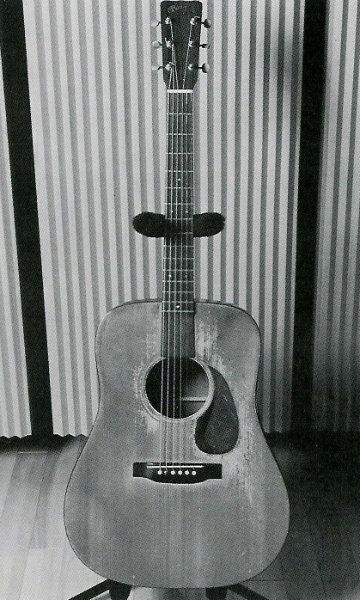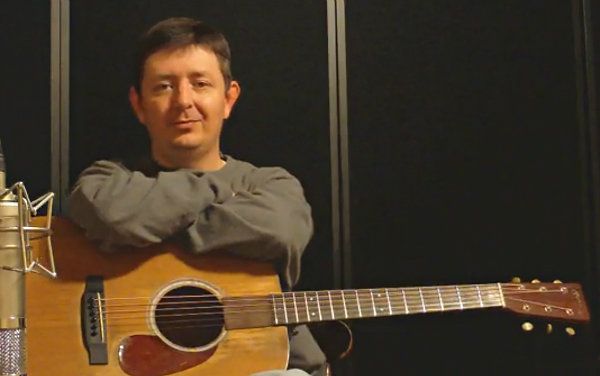
 |
|
#1
|
|||
|
|||
|
Hi, I'm a long-time lurker and don't recall this topic coming up for discussion - I've been wondering about this issue for a while and wanted to know your thoughts on this...
Specifically, I'm concerned with the bit of fretboard that lies beyond the 12/14th fret and lies on top of the guitar body. Is there a good reason as to why this is glued to the soundboard? Is it detrimental to the structural strength or tone of an acoustic guitar if it is left floating? About the only things I could come up with are: 1. Sometimes, when one's fret slots are a little tight, the f'board will backbow and glueing to the soundboard will keep it flat... 2. It helps to couple the neck to the transverse brace? 3. Er, I dunno! So, any opinions out there? Cheers, Al |
|
#2
|
|||
|
|||
|
Hi Al
My Berg OM's fretboard extension is floating and the neck angle is fully adjustable - it was built that way by my request. The guitar hasn't got a Popsicle brace either. The upper bout vibrates freely and the guitar is pure joy to play (and to hear)... The McPherson guitars have also got floating fretboard extensions. Zohn
__________________
1992 Taylor 555 12 string 2013 Kronbauer MJ Sitka/Koa 2005 Larrivee J-05 2018 Larrivee 00-40 Custom 2017 Thompson HardRed Dread 2013 Jacobs SJ Sitka/Pao Rosa 2013 Eastman E20OM 2002 Takamine EAN60C 1997 Seagull Grand |
|
#3
|
|||
|
|||
|
When the fretboard is glued to the top, it is usually an integral part of the structure used to support string tension.
|
|
#4
|
|||
|
|||
|
If it isn't glued and is normal size (ie; 4-5mm thick) then you will lose tone on those frets and perhaps get some bad vibrations. A local builder built a guitar with a raised (floating) fingerboard with standard fingerboard thickness, and the fingerboard actually would bend when fretting notes there with a dull thunk sound rather than a true guitar tone. Raised or adjustable fingerboards require support underneath.
__________________
---- Ned Milburn NSDCC Master Artisan Dartmouth, Nova Scotia |
|
#5
|
|||
|
|||
|
Thanks all for your input - it's a little clearer in my mind now...
|
|
#6
|
|||
|
|||
|
Grammy-award nominee Chris Sharp (O’ Brother, Where Art Thou?) modified his 1989 Martin D-16 by removing the upper frets and thinning - not eliminating - the extension to "make the top vibrate more. I was there before each procedure, on each of my guitars, and after there is no doubt to my ears that they sound better. Logic dictates that more vibrations will project more sound, since sound is only vibrations to begin with." This is the same goal desired by removing the popsicle brace:
 Frank Ford summarized Chris' modification this way: "The fingerboard has precious little strength in the up-and-down direction, so it cannot possibly press down to crack the top. The cracks that appear in that area have their genesis in cross grain shrinkage of the spruce, plain and simple. "There is a big structural advantage to the fingerboard extension glued to the top, and that's a matter of lateral support in case of a blow sideways to the neck. And, yes, I have seen considerable damage done to instruments in that way. Those instruments were ones in which the neck had been reset by cutting the fingerboard off at the 14th fret for easier removal - a technique that has largely been abandoned for that reason, among others." You can see Chris and his guitar in action in his instructional videos on playing guitar in the style of Lester Flatt: http://www.youtube.com/watch?v=lbbxhcqUwTM 
|
|
#7
|
|||
|
|||
|
Quote:
It is not the path I have taken as I decided to elimanate the popsicle brace and go with an A frame into a traditional neck block. Primarily to try to add some longevity between potential neck resets. However I would be interested to hear anyones thoughts on L and C shaped neck blocks or for that matter Spanish heels in relation to what Frank Ford has said in regard to cracking. As in why dont we see more cracking with these approaches.....or do you? Jeff. P.S. with apologies to the OP. Last edited by jeff crisp; 07-21-2012 at 08:46 PM. Reason: because English is not my first language, monosyllabic grunting is |
|
#8
|
|||
|
|||
|
Jeff,
I've used "L", "C" and traditional blocks, but I don't understand what you are asking, particularly in relation to Frank Ford's quote. Clearly, based on his experience, the fingerboard extension, when glued to the top, offers side-to-side strength to the neck joint. That doesn't really have anything to do with the type of block that is inside the guitar. |
|
#9
|
|||
|
|||
|
Quote:
"After removing the popsicle brace, my solution is to add a new brace. [NOTE: my new brace is a little different from the one shown. After discussion with John Arnold, I now make this brace trapezoidal rather than rectangular and I bevel the edges more." As a player only, I've found some guitars with the popsicle brace removed to have become too airy and thin for my liking. |
|
#10
|
|||
|
|||
|
Hi Charles, the cracks that can appear on the top along side the fretboard. Frank ford seems to be saying they only appear from cross grain shrinkage. Which Im guessing is one thing the popsicle brace would help to prevent.
My question is if C or L shaped blocks are employed wouldnt we see even more cracks in the same area with the removal of the popsicle brace? Why would so many people take that risk? Including You and me. Am I missing something here. Thanks Jeff |
|
#11
|
|||
|
|||
|
Quote:
Looking at the picture this approach would seem to me to only help with the ''up and down'' direction that Frank dismisses. Any protection offered from cross grain shrinkage has only increased by a few mm either side of the fretboard. Thanks Jeff. Last edited by jeff crisp; 07-22-2012 at 03:26 AM. |
|
#12
|
|||
|
|||
|
Just read Brian Kimseys ideas on cracking in the area of concern and it is the same as what I was taught.
He proposed that the cracks are caused primarily by the neckblock leaning forward, which it will over time and under stress. This apears to me to be at odds with Frank Fords statement that "the cracks that appear in that area have their genesis in cross grain shrinkage of the spruce, plain and simple". Jeff. |
|
#13
|
|||
|
|||
|
Quote:
I've never used the popsicle brace, but would conjecture that others use it because they are copying a tradition or because they want to add additional structure in that area, or both. I'd hazard a guess that it doesn't do much to prevent humidity-related cracking along the sides of the fingerboard. Quote:
An awful lot of stuff is taken on faith or mythology and then repeated. There is an awful lot of stuff that is unknown about how the guitar functions and behaves. There are, however, lots of theories and lots of religious-like convictions. The bottom line appears to be, "Do what works for you (and your customers)." Quote:

Last edited by charles Tauber; 07-22-2012 at 06:42 AM. |
|
#14
|
|||
|
|||
|
No Charles, I never suggested that the popsical stick brace would stop dimensional changes of the wood due to humidity. Only that it would help prevent cracks appearing. As you basically have agreed with me by saying that "it doesnt do much to prevent it". Like me you would not rule it out completely.
I am not assuming for one second that without the popsical brace that the top will crack. As already stated I dont use them either. I have been trying to get a response from somebody who was braver than me in saying Frank Ford was wrong. Because that is what I have been asumming I tryed to take a gentle approach with this as I am only an intermediate builder and am obviously not respected by some people here. As I have already stated in above post, Brian Kimsey proposed that the cracks are caused primarily by the neckblock leaning forward over time which as I have already said is what I was taught. Frank Ford states that "the cracks that appear in the area have their genesis in cross grain shrinkage of the spruce, plain and simple'. To through your line back at you, what you are missing is that you are making assumptions. It never mattered to me what the popsical stick did, it was what was primarily the caused of cracks in the said area. Yes I have been told from day one that there is a lot of mythology with builders and that is why I dont take anything on faith. As Mario Prolux once said even Ervin could learn a thing or two. Jeff. |
|
#15
|
|||
|
|||
|
Well Charles, Im a very slow typer and also spent alot of time reading what you had posted before you edited it (a copy of which I still have)and I must say I was quite annoyed (not the first time it has felt like extracting teeth).So my last post was to your unedited version. Which by the time I posted it( after midnight on a sunday)I was not aware of your changes,................
Thanks Jeff. |